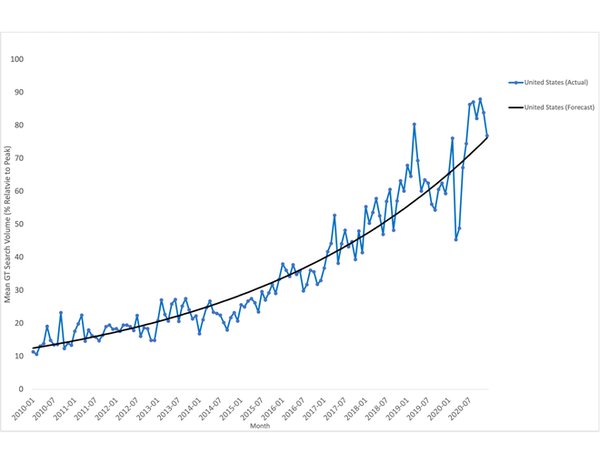-
Home
-
About JCTR
-
Gold Open Access
-
Issues
-
Editorial board
-
Author guidelines
-
Publication fees
-
Online first
-
Special issues
-
News
-
Publication ethics
-
Partners
-
Submit your manuscript
-
Submit your review report
-
Editorial Office
-

This work is licensed under a Creative Commons Attribution-NonCommercial 4.0 International License. ISSN print: 2382-6533 ISSN online: 2424-810X
Volume 9 Issue 2
The use of Google Trends and Twitter data as a tool for evaluating public interest in hyaluronic acid eyelid filler
Samuel A Cohen, Andrea L. Kossler*
Cohen et al. J Clin Transl Res 2023; 9(2):3
Published online: February 6, 2023
Abstract
Background: Google Trends and the Twitter Academic Research Product Tract (TARPT) are free, online tools that can be used to evaluate public interest in plastic surgery procedures.
Aim: To evaluate the correlation between online public interest in hyaluronic acid eyelid filler on two popular web platforms (Google and Twitter) and hyaluronic acid filler procedure volumes in the United States.
Methods: The Google Trends database and the TARPT tool were used to calculate the number of annual Google searches and Twitter tweets, respectively, related to 10 search terms associated with hyaluronic acid eyelid filler injections from January 2010 to December 2020. Annual procedure volumes for hyaluronic acid filler injections were obtained from the American Society of Plastic Surgery (ASPS). Univariate linear regression was used to correlate Google searches to ASPS procedure volumes and Twitter tweet volumes to ASPS procedure volumes.
Results: Significant positive correlations were found between Google Trends data and ASPS procedure volumes for 8/10 search terms and between Twitter tweet volumes and ASPS procedure volumes for 6/10 search terms, respectively. Online public interest in eyelid filler related search terms increased significantly over time according to an exponential model (p < 0.0001).
Conclusions: We observed statistically significant positive associations between public interest related to eyelid filler on two online platforms, Google and Twitter, and hyaluronic acid soft tissue filler procedure volumes. The Google Trends and TARPT databases represent free information sources for surgeons that may be used to inform marketing and advertising decisions and to anticipate patient inquiries during the patient encounter.
Relevance for patients: Information provided by the Google Trends and TARPT tools can be used by surgeons to (1) inform marketing and advertising strategies and (2) gain insight into which procedures patients are researching during a given time period, preparing them to best address the evolving needs of patients.

DOI: http://dx.doi.org/10.18053/jctres.09.202302.003
Author affiliation
Byers Eye Institute at Stanford, Department of Ophthalmology, Stanford University School of Medicine. Stanford, CA, United States of America
*Corresponding author
Andrea L. Kossler
Director of Ophthalmic Plastic, Reconstructive
Surgery, and Orbital Oncology, Byers
Eye Institute at Stanford, Department of
Ophthalmology, Stanford University School
of Medicine, Stanford, CA, United States of
America.
Email: akossler@stanford.edu
Handling editor:
Michal Heger
Department of Pharmaceutics, Utrecht University, the Netherlands
Department of Chemistry, Utrecht University, Utrecht, the Netherlands
Department of Pathology, Erasmus Medical Center, the Netherlands
Department of Pharmaceutics, Jiaxing University Medical College, Zhejiang, China

